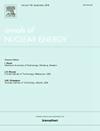Correcting nuclide concentration fields and optimizing monitoring locations based on environmental-monitoring data
IF 1.9
3区 工程技术
Q1 NUCLEAR SCIENCE & TECHNOLOGY
引用次数: 0
Abstract
Radioactive materials can be released into the external environment after nuclear facility accidents. Therefore, it is necessary to rapidly assess the spatial distribution of radioactive nuclides. Using only the concentration distribution of radioactive nuclides predicted by the atmospheric dispersion models may result in deviations from the actual concentration distribution. To make the predicted distribution more consistent with the actual distribution, a method based on Kriging interpolation was developed to rapidly correct the predicted concentration distribution using a small amount of environmental aerosol monitoring data. In addition, a method for optimizing environmental aerosol monitoring locations based on a differential evolution algorithm was developed to guide the placement of more representative monitoring locations and improve the accuracy of the corrected concentration distribution. The results indicated that using optimized monitoring locations to obtain environmental monitoring data enhanced the accuracy of prediction in key areas in the constructed case-studies, reducing false-negative areas by 97%.
求助全文
约1分钟内获得全文
求助全文
来源期刊

Annals of Nuclear Energy
工程技术-核科学技术
CiteScore
4.30
自引率
21.10%
发文量
632
审稿时长
7.3 months
期刊介绍:
Annals of Nuclear Energy provides an international medium for the communication of original research, ideas and developments in all areas of the field of nuclear energy science and technology. Its scope embraces nuclear fuel reserves, fuel cycles and cost, materials, processing, system and component technology (fission only), design and optimization, direct conversion of nuclear energy sources, environmental control, reactor physics, heat transfer and fluid dynamics, structural analysis, fuel management, future developments, nuclear fuel and safety, nuclear aerosol, neutron physics, computer technology (both software and hardware), risk assessment, radioactive waste disposal and reactor thermal hydraulics. Papers submitted to Annals need to demonstrate a clear link to nuclear power generation/nuclear engineering. Papers which deal with pure nuclear physics, pure health physics, imaging, or attenuation and shielding properties of concretes and various geological materials are not within the scope of the journal. Also, papers that deal with policy or economics are not within the scope of the journal.
 求助内容:
求助内容: 应助结果提醒方式:
应助结果提醒方式:


